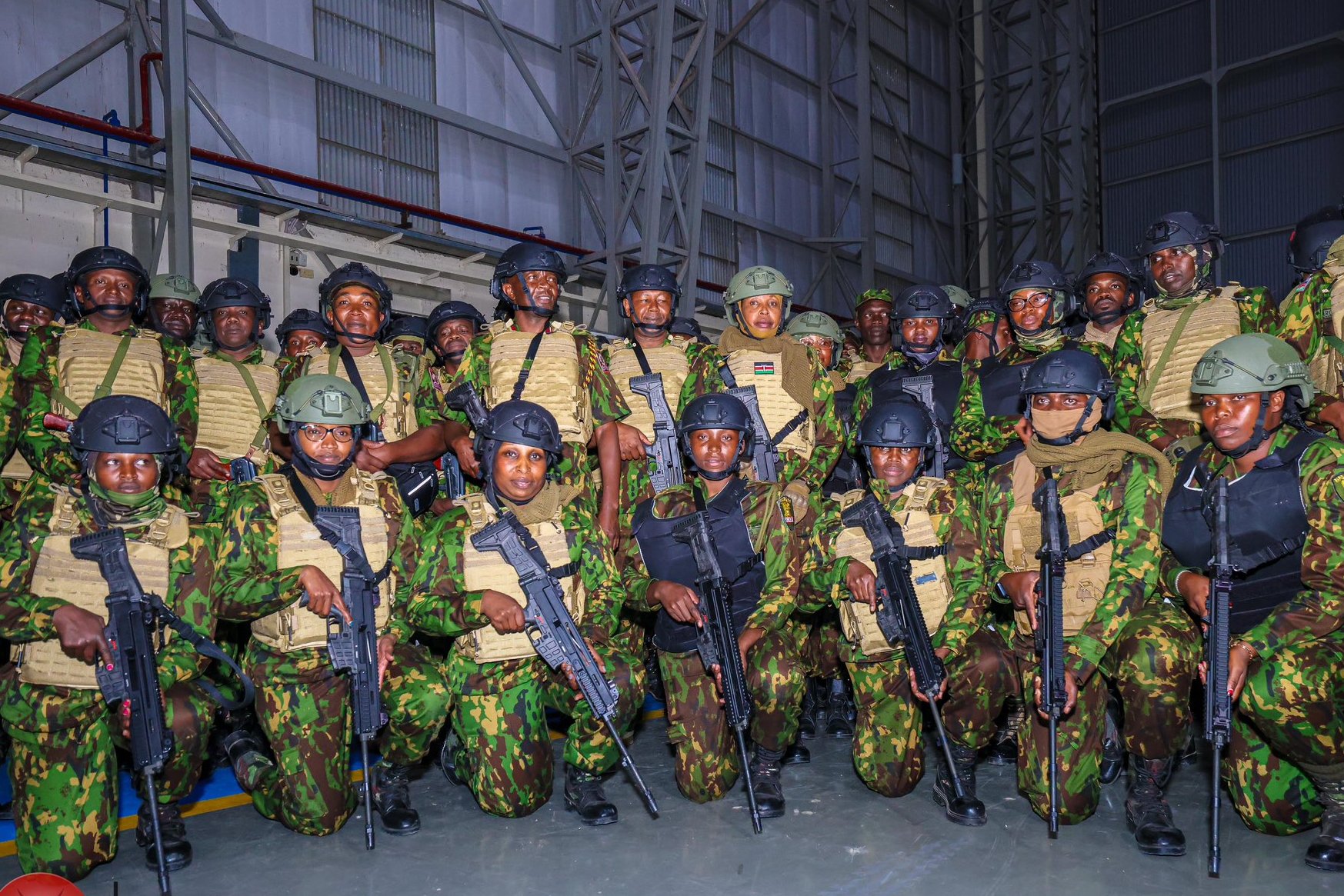Opinion
Expert Take: Are Female Police Officers Really Less Effective?
The evidence overwhelmingly contradicts the Nyahururu OCS’s position.

Operational evidence contradicts controversial call to reduce women’s recruitment in Kenya Police Service
When Nyahururu Officer Commanding Station Isaac Kimutus claimed that female police officers “vomited in their helmets” during recent protests and called for reducing women’s recruitment to just 20%, he ignited a debate that goes beyond politics to the heart of modern policing effectiveness.
But does the operational evidence support his controversial stance?
A comprehensive analysis of policing research, international deployments, and Kenya’s own track record suggests the answer is a resounding no.
During the 23rd Jukwaa La Usalama Forum in Laikipia County on July 31, 2025, OCS Kimutus made headlines with his blunt assessment of female officers’ performance during the Gen Z protests of June 25 and July 7.
“Kama ingewezekana kuandika wanawake iwe 20 percent. The rest waandikwe wanaume,” he declared, explaining that he had instructed female officers to remain at stations during volatile situations because “unakuta wanatapikia helmet” (you find them vomiting in their helmets).
The National Police Service swiftly disowned the remarks as “personal and inappropriate,” with spokesperson Muchiri Nyaga emphasizing that women “continue to play a critical role in policing, law enforcement, and professional service delivery.”
Interior Cabinet Secretary Kipchumba Murkomen and Inspector General Douglas Kanja, who were present during the forum, dismissed the comments as poorly phrased, with Murkomen noting the officer “did not know how to package his words.”
What the evidence actually shows
Security experts examining the OCS’s claims find them fundamentally flawed when measured against operational realities and empirical research.
Modern policing effectiveness isn’t primarily determined by physical confrontation capabilities.
Research consistently demonstrates that successful crowd control relies on tactical coordination, equipment proficiency, and psychological preparation rather than individual physical strength.
Studies show that female officers are 27% less likely to use extreme controlling behaviors, suggesting superior de-escalation capabilities—precisely what’s needed in volatile protest situations.
This finding directly contradicts the assumption that physical confrontation is the primary measure of policing effectiveness.
Kenya’s own international deployments provide the strongest counter-evidence to the OCS’s position.
Kenyan female police officers currently serve with distinction in UN peacekeeping missions globally, achievements the NPS notes were “attained through merit, dedication, and professional competence, not chance.”
Most notably, Kenya has deployed all-women police contingents to international missions, including Haiti, where they’ve earned recognition for their professionalism and effectiveness in community policing.
The real operational picture
Security analysts point to specific operational advantages that female officers bring to modern policing.
Women officers demonstrate enhanced performance in domestic violence response, superior capabilities in child protection investigations, and better community engagement, particularly with women and children.
They also improve public trust and police legitimacy while offering alternative approaches to conflict resolution.
The allegation about officers experiencing physical distress during operations, if accurate, points to training deficiencies rather than gender-based incapacity.
Stress responses to volatile situations affect both male and female officers and are addressed through enhanced training protocols, not exclusion policies.
“The OCS may have legitimate concerns about training adequacy for high-stress situations or equipment suitability, but these are operational issues, not gender issues,” notes one security analyst who requested anonymity.
Kenya’s Constitution mandates one-third gender representation in public service—a requirement rooted in both equity and operational effectiveness.
This isn’t mere political correctness but recognition that diverse police forces better serve diverse communities.
Reducing female recruitment based on isolated incidents would violate constitutional requirements, undermine Kenya’s international commitments, reduce operational effectiveness in community policing, and damage public trust and legitimacy.
The implications extend far beyond domestic policy, potentially affecting Kenya’s standing in international security partnerships.
Rather than reducing female recruitment, security experts recommend Kenya focus on comprehensive improvements to its police force.
Enhanced training through rigorous psychological preparation and stress inoculation training for all officers regardless of gender represents the first priority. Strategic deployment involving mixed teams that leverage different skill sets and match officer capabilities to operational requirements offers another avenue for improvement.
Equipment optimization ensuring all protective gear accommodates physical diversity while maintaining effectiveness, combined with merit-based standards that establish clear, measurable performance criteria focused on capability rather than assumptions, would address legitimate operational concerns without resorting to discriminatory practices.
Expert analysis
Kenya’s approach to police gender integration is watched globally, particularly given the country’s leadership in peacekeeping deployments.
The success of Kenyan female officers in international missions has enhanced the country’s reputation and soft power influence.
Retrograde policies would not only harm domestic policing effectiveness but could jeopardize Kenya’s standing in international security partnerships.
The consensus among security analysts is clear: the Nyahururu OCS’s comments reflect outdated thinking that conflates physical confrontation with policing effectiveness.
“Modern security challenges require diverse skill sets that gender-balanced forces provide more effectively than homogeneous units,” explains Dr. Sarah Kimani, a security studies expert at the University of Nairobi.
“Kenya’s female police officers have proven their worth on international stages—our security apparatus is stronger, not weaker, because of gender diversity.”
Bottom line
The evidence overwhelmingly contradicts the Nyahururu OCS’s position.
Effective policing in the 21st century requires strategic thinking over physical force, community trust over authoritarian control, and professional competence regardless of gender.
The path forward lies not in exclusion but in excellence—ensuring all officers meet the highest professional standards while leveraging the operational advantages that diversity provides.
The National Police Service was correct to disown the controversial remarks.
Kenya’s security is best served by recruiting the best candidates regardless of gender and ensuring they receive the training and support necessary to excel in their duties.
As the debate continues, one question remains: In an era where policing effectiveness is measured by community trust, crime prevention, and professional competence, can Kenya afford to exclude half its potential talent pool based on outdated assumptions?
The operational evidence suggests the answer is clear.
Kenya Insights allows guest blogging, if you want to be published on Kenya’s most authoritative and accurate blog, have an expose, news TIPS, story angles, human interest stories, drop us an email on [email protected] or via Telegram
-

 Investigations6 days ago
Investigations6 days agoBillions Stolen, Millions Laundered: How Minnesota’s COVID Fraud Exposed Cracks in Somali Remittance Networks
-

 News1 week ago
News1 week agoUS Moves to Seize Luxury Kenya Properties in Sh39 Billion Covid Fraud Scandal
-

 Investigations6 days ago
Investigations6 days agoJulius Mwale Throws Contractor Under the Bus in Court Amid Mounting Pressure From Indebted Partners
-

 News1 week ago
News1 week agoMAINGA CLINGS TO POWER: Kenya Railways Boss Defies Tenure Expiry Amid Corruption Storm and Court Battles
-

 Americas6 days ago
Americas6 days agoUS Govt Audits Cases Of Somali US Citizens For Potential Denaturalization
-

 Americas1 day ago
Americas1 day agoTrump Says US Needs Greenland For Its National Security
-

 Sports1 day ago
Sports1 day agoThe Easy Way to MSport Ghana: From Login to Your First Bet
-

 Sports1 day ago
Sports1 day agoWhat Makes Yesplay the Go-To Gambling Platform for South Africans?












